Overview back to the top ↑
What are the smallest things we know of, and just how small are they? This lesson explores how small quarks, the smallest thing we know of, are by cutting paper and relating this to everyday objects.
Grades: 1-5 (National Standards)
Time: 45 minutes to an hour
Background back to the top ↑
Atoms can be thought of as the basic building blocks of everything in the universe. Scientists used this concept to study early chemistry and radiation. Later, scientists discovered that atoms were made up of smaller particles called protons, neutrons, and electrons (electrons are the particles that we associate with electricity). In the late 60's, particle physicists discovered that protons and neutrons are made up of even smaller particles, they called quarks. Quarks and electrons are the smallest particles known. The following table that shows how many cuts it takes to get to the size of a quark.
| Examples of typical sizes | |||
|---|---|---|---|
| Cut 1 | 14.0 cm | 5.5 in | Small book, hand |
| Cut 2 | 7.0 cm | 2.75 in | Fingers, apple |
| Cut 3 | 3.5 cm | 1.38 in | Watch, mushroom |
| Cut 4 | 1.75 cm | .69 in | Keyboard keys, rings, insects |
| Cut 6 | .44 cm | .17 in | Peas, poppy seeds |
| Cut 8 | 1 mm | .04 in | Thread, sharp pencil width |
| Cut 10 | .25mm | .01 in | If you can cut this small, you are superhuman! |
| Cut 12 | .06 | .002 in | Microscopic range, human hair |
| Cut 14 | .015 mm | .006 in | Width of paper, microchip components |
| Cut 18 | 1 micron | .0004 in | Water purification openings, bacteria |
| Cut 19 | .5 micron | .000018 in | Visible light waves |
| Cut 24 | .015 micron | .0000006 in | Electron microscope range, DNA, membranes |
| Cut 31 | 1×10-10 m (move the decimal 10× to the left) | 4.5×10-9 in (move the decimal 9× to the left) | The size of an atom! |
| Cut 41 | A little more than 1×10-15 m | A little more than 4×10-14 in | The size of the nucleus of an atom (the largest nuclei would be this amount x10) |
| Cut 58 | A little less than 1×10-18 m | A little less than 4×10-18 in | The upper limit on the size of Quarks! |
In the table, the metric units given are:
| Meter | m | about 39 inches |
| Centimeter | cm | 10-2m = 0.01m |
| Millimeter | mm | 10-3m = 0.001m |
| Micron | μm | 10-6m = 0.000001m |
Objective back to the top ↑
Cut a 28 cm long by 1 cm wide strip of paper in half as many times as possible.
Materials back to the top ↑
Each student needs:
- copy of worksheet (printed out on letter - 8.5 x 11 inch paper)
- pencil
- a 28cm long by 1cm wide (11 inch by about .4 inch wide) strip of colored paper (Prepare these ahead of time.)
- scissors
Procedure back to the top ↑
- Have the students use their pencils to shade in the “No cuts” area between the dashed lines.
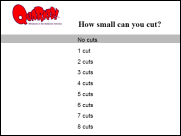
- Have the students line up their strip of paper directly underneath the “No Cuts” section of the worksheet. See that this section is the same length as the piece of paper.
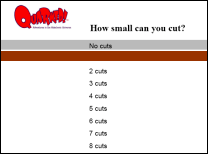
- Have the students fold their paper strip in half , then cut along the fold. They now should have two 14cm long strips of paper.
- Have students discard one of the halves. They should then line up the remaining half directly underneath the “No Cuts” section on the worksheet on the left hand side.
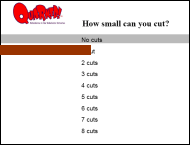
- Have the students use their pencil to trace the outline of the paper on their worksheet, then remove the strip of paper and shade in the box.
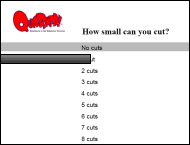
- Repeat steps three through five until they can make no more cuts.
Results and Discussion back to the top ↑
The worksheet should look like the following picture after completion of the procedures.
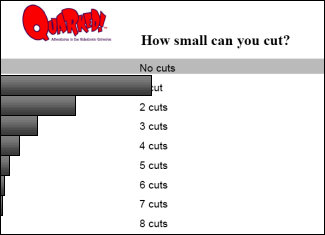
Question: How many cuts could you make? (Normally students can make about 7–8 cuts.)
Question: Name one thing that is the same size as the paper with 1 cut, 3 cuts, 5 cuts (see table in background section)
Question: How many hairs wide do you think your smallest piece is? (Seven cuts is about 20 hair widths.)
Question: If you could cut the paper in half 20 times, would the paper be bigger or smaller than the following: 1 hair – smaller, a germ (bacteria) – smaller, and an atom (the tiny building block of everything in the universe) – bigger.
Question: Quarks are the smallest things known to scientists. How many times do you think you would have to cut the paper to get to the size of a quark? (at least 58)
Question: How do you think you could keep cutting the paper smaller and smaller. (Scientists are now able to see things that are the size of an atom and smaller but they don't use scissors. In fact, they don't cut things, they smash them together. Particle physicists speed up subatomic particles to make them go very fast then smash them together to break them into smaller bits like quarks.)
Follow up activities back to the top ↑
- Look at hair and cells (skin or other) beneath a microscope to obtain a better idea of the scale of the smallest things that we can see visually.
- Visit the Quarked web site (Quarked.org) to play Ushi's ruler game.
- Visit the Fermilab's particle physics education site (www.fnal.gov) to learn about the smallest particles that we know of and how we know that they exist.
National Standards back to the top ↑
This lesson plan addresses the following national standards in science and math:
Science
- Standard A – Science as Inquiry
Students should develop abilities necessary to do scientific inquiry and an understanding about scientific inquiry. - Standard B – Physical Science
Students should develop an understanding of the properties of objects and materials and the position and motion of objects. - Standard G – History and Nature of Science
Students should develop understanding of the nature of science.
Math
Understand numbers, ways of representing numbers, relationships among numbers, and number systems
- Use multiple models to develop initial understandings of place value and the base-ten number system
- Connect number words and numerals to the quantities they represent, using various physical models and representations
- Understand the place-value structure of the base-ten number system and be able to represent and compare whole numbers and decimals
Understand patterns, relations, and functions
- Sort, classify, and order objects by size, number, and other properties
- Represent and analyze patterns and functions, using words, tables, and graphs
Understand measurable attributes of objects and the units, systems, and processes of measurement
- Recognize the attributes of length, volume, weight, area, and time
- Compare and order objects according to these attributes
- Understand the need for measuring with standard units and become familiar with standard units in the customary and metric systems
- Carry out simple unit conversions, such as from centimeters to meters, within a system of measurement
Apply appropriate techniques, tools, and formulas to determine measurements
- Measure with multiple copies of units of the same size, such as paper clips laid end to end
- Use tools to measure
- Develop common referents for measures to make comparisons and estimates
Data Analysis and Probability Standard - Formulate questions that can be addressed with data and collect, organize, and display relevant data to answer them
- Pose questions and gather data about themselves and their surroundings
- Sort and classify objects according to their attributes and organize data about the objects
- Represent data using concrete objects, pictures, and graphs
